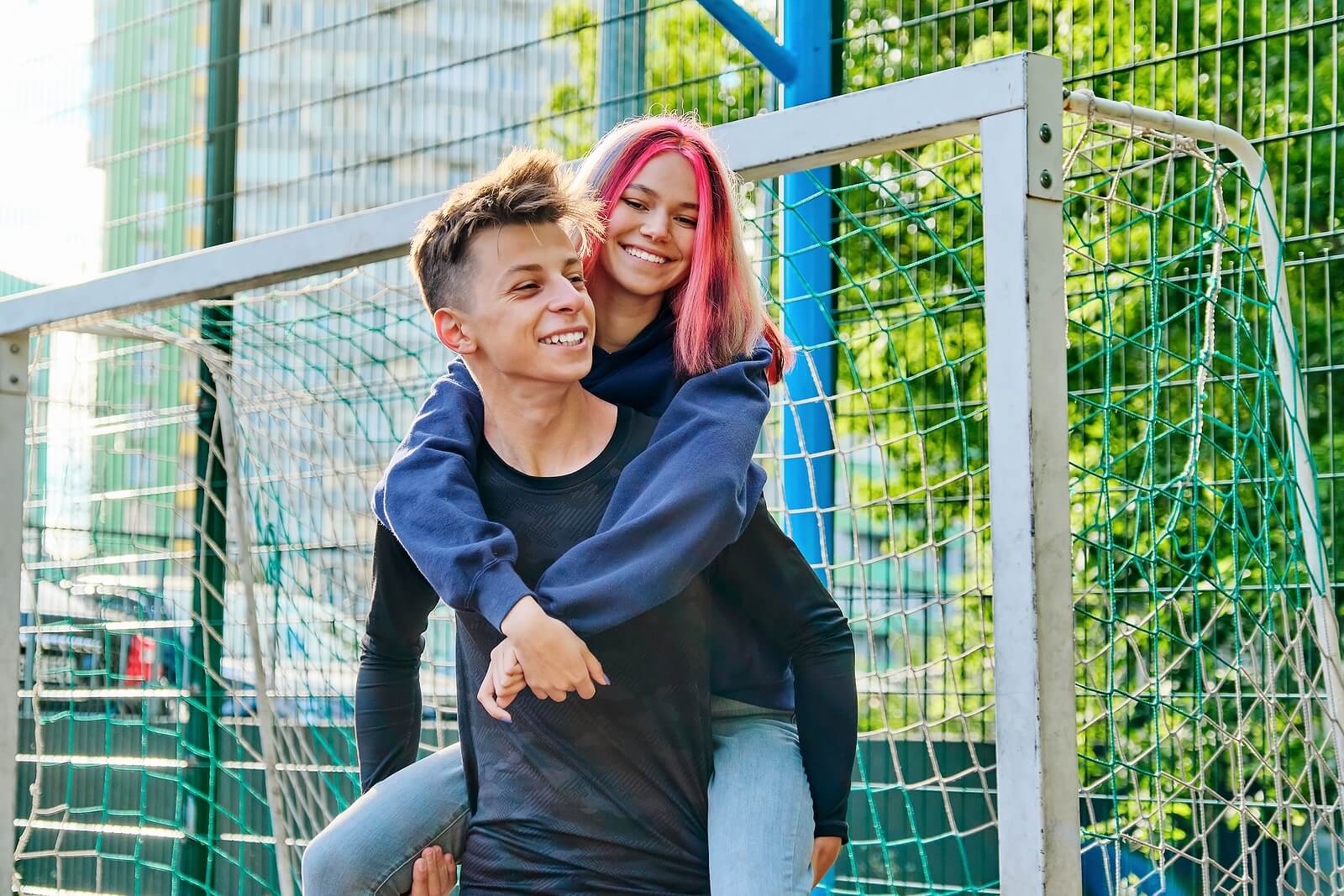Talking About Sexual Orientation With Adolescents

Sexual orientation is an aspect that causes many doubts among young people. There are occasions in which adolescents haven’t completely defined their sexuality and this causes them concern. What happens at this age is that the doubts they have regarding their sexuality are difficult to express; sometimes because of embarrassment and other times for fear of what others think. So, how can we talk about sexual orientation with adolescents?
During puberty, sexual attraction begins, especially due to hormonal changes at this stage. These changes not only involve the body, but also the mind, so if they think someone’s attractive, physical arousal can occur. It’s in this period that boys and girls begin to discover what it means to be attracted to someone; admitting their sexual orientation is part of this process.
Sexual orientation in adolescence, what is it?
When we talk about sexual orientation we refer to the gender (female or male) to which a person is attracted. There are several types:

- Homosexual: People who are attracted to people of the same sex. A lesbian is a woman who’s attracted to another woman and gay refers to a man who’s attracted to another man.
- Heterosexual: People who are attracted to the opposite sex. Women are attracted to men and men are attracted to women.
- Bisexual: People who are attracted to both sexes.
Recommendations for talking about sexual orientation with adolescence
When discussing sexuality with children, parents need to have a facilitative and open mind and attitude. It’s important that sex education for children begins at home and continues in schools. When parents and children have a relationship based on trust and with an open disposition, this process will be much easier.
Parents should have conversations about sex with their children to explain false myths and deal with the misinformation they may get from the Internet or their friends. What can parents do?
Make appropriate use of language when talking about sexual orientation with adolescents
To talk about sexual orientation issues, it’s a good idea to use a neutral gender, that is, use words such as someone, couple, teenage relationships, people, instead of girl/boyfriend. In addition, any pejorative words about their sexual status, such as butch or sissy, should be removed from your vocabulary, and theirs.
The situation should be normalized
Keep an open mind when talking to adolescents about sexual orientation. How you approach it will depend a lot on your family and its values. What you need to comprehend is that a person’s sexual orientation has to be understood as just another characteristic, like being tall or short. The situation should be normalized and not turned into a taboo.
Be attentive to how they feel and address their doubts
The physical changes that occur during adolescence due to sexual development can make young people feel worried and embarrassed. Parents should be attentive to these feelings in order to help them and resolve any doubts they may have. It’s important to be close to your children so that they can express the emotions they’re feeling to help them.
During conversations with children, avoid excessive questions about their sexual intimacy

When talking to children about sexual orientation, it’s important not to interrupt when they open up to ask awkward questions about their intimacy, such as if they’ve had sex, with whom, how, etc. They should be left to tell what they need to tell and take the initiative if they feel it’s appropriate, without pressure of any kind.
As far as talking about sexual orientation with adolescence is concerned…
Sexual orientation in adolescence is one of the things that most concerns young people; they haven’t yet defined their sexual tendency and, in addition, there are many taboos regarding homosexuality, especially. As parents, it’s important to have an open mind and address this issue regardless of the adolescent’s sexual orientation.
The key is to accompany, understand, and help solve all the doubts that children have about sexuality. This can be very helpful in identifying what they feel.
Sexual orientation is an aspect that causes many doubts among young people. There are occasions in which adolescents haven’t completely defined their sexuality and this causes them concern. What happens at this age is that the doubts they have regarding their sexuality are difficult to express; sometimes because of embarrassment and other times for fear of what others think. So, how can we talk about sexual orientation with adolescents?
During puberty, sexual attraction begins, especially due to hormonal changes at this stage. These changes not only involve the body, but also the mind, so if they think someone’s attractive, physical arousal can occur. It’s in this period that boys and girls begin to discover what it means to be attracted to someone; admitting their sexual orientation is part of this process.
Sexual orientation in adolescence, what is it?
When we talk about sexual orientation we refer to the gender (female or male) to which a person is attracted. There are several types:

- Homosexual: People who are attracted to people of the same sex. A lesbian is a woman who’s attracted to another woman and gay refers to a man who’s attracted to another man.
- Heterosexual: People who are attracted to the opposite sex. Women are attracted to men and men are attracted to women.
- Bisexual: People who are attracted to both sexes.
Recommendations for talking about sexual orientation with adolescence
When discussing sexuality with children, parents need to have a facilitative and open mind and attitude. It’s important that sex education for children begins at home and continues in schools. When parents and children have a relationship based on trust and with an open disposition, this process will be much easier.
Parents should have conversations about sex with their children to explain false myths and deal with the misinformation they may get from the Internet or their friends. What can parents do?
Make appropriate use of language when talking about sexual orientation with adolescents
To talk about sexual orientation issues, it’s a good idea to use a neutral gender, that is, use words such as someone, couple, teenage relationships, people, instead of girl/boyfriend. In addition, any pejorative words about their sexual status, such as butch or sissy, should be removed from your vocabulary, and theirs.
The situation should be normalized
Keep an open mind when talking to adolescents about sexual orientation. How you approach it will depend a lot on your family and its values. What you need to comprehend is that a person’s sexual orientation has to be understood as just another characteristic, like being tall or short. The situation should be normalized and not turned into a taboo.
Be attentive to how they feel and address their doubts
The physical changes that occur during adolescence due to sexual development can make young people feel worried and embarrassed. Parents should be attentive to these feelings in order to help them and resolve any doubts they may have. It’s important to be close to your children so that they can express the emotions they’re feeling to help them.
During conversations with children, avoid excessive questions about their sexual intimacy

When talking to children about sexual orientation, it’s important not to interrupt when they open up to ask awkward questions about their intimacy, such as if they’ve had sex, with whom, how, etc. They should be left to tell what they need to tell and take the initiative if they feel it’s appropriate, without pressure of any kind.
As far as talking about sexual orientation with adolescence is concerned…
Sexual orientation in adolescence is one of the things that most concerns young people; they haven’t yet defined their sexual tendency and, in addition, there are many taboos regarding homosexuality, especially. As parents, it’s important to have an open mind and address this issue regardless of the adolescent’s sexual orientation.
The key is to accompany, understand, and help solve all the doubts that children have about sexuality. This can be very helpful in identifying what they feel.
All cited sources were thoroughly reviewed by our team to ensure their quality, reliability, currency, and validity. The bibliography of this article was considered reliable and of academic or scientific accuracy.
- Cortés Alfaro, A., Pérez Sosa, D., Aguilar Valdés, J., Valdés Hernández, M. M., & Taboada Fernández, B. (1998). Orientación sexual en estudiantes adolescentes. Revista Cubana de Medicina General Integral, 14(5), 450-454. http://scielo.sld.cu/scielo.php?pid=S0864-21251998000500008&script=sci_arttext&tlng=pt
- González, E., Martínez, V., Leyton, C., & Bardi, A. (2004). Orientación sexual: un desafío actual para la atención de adolescentes. Rev. Sogia, 11(3), 69-78. http://tiempodehablar.paniamordigital.org/files/Descargas/files/4_165_orientacinsexualundesafoactualparalaatencindeadolescentes.pdf
This text is provided for informational purposes only and does not replace consultation with a professional. If in doubt, consult your specialist.








